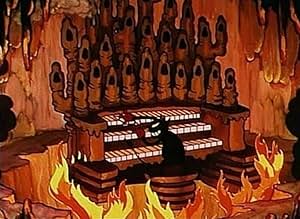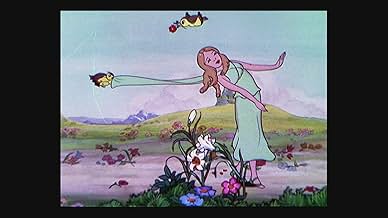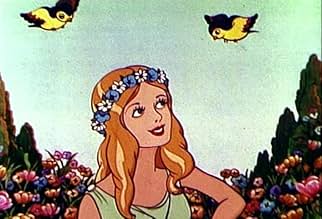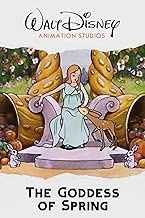IMDb RATING
6.6/10
1.6K
YOUR RATING
The lovely goddess of spring, Persephone, is kidnapped by Hades, thus bringing about the winter season.The lovely goddess of spring, Persephone, is kidnapped by Hades, thus bringing about the winter season.The lovely goddess of spring, Persephone, is kidnapped by Hades, thus bringing about the winter season.
- Director
- Writer
- Stars
Kenny Baker
- Singing Narrator
- (voice)
- (uncredited)
Jessica Dragonette
- Goddess of Spring
- (voice)
- (uncredited)
Tudor Williams
- Pluto
- (voice)
- (uncredited)
- Director
- Writer
- All cast & crew
- Production, box office & more at IMDbPro
Featured reviews
While charming on its own merits, this short really shows how far the Disney animators came in the three years between this and Snow White and the Seven Dwarfs. The movements of the leading lady of The Goddess of Spring are awkward and somewhat grotesque; her limbs seem to flail about as she skips to her throne, and she does not seem to possess any bones or weight at all. As Frank Thomas and Ollie Johnston said in their book "The Illusion of Life", there was no way she would have ever been able to carry an animated film.
But like I said, the short is cute. It's a decent retelling of Greek myth; it excludes Persephone's mother Demeter from the tale, but this is understandable as the story has to be compressed to keep a ten minute running time. Some of the music is in the operetta style, which I'm not too keen on, but there's a cool jazz number in the first underworld scene, where Hades' demons sing of "Mighty Hades". Overall, if you're an animation buff you're more likely to enjoy this than the casual viewer; while there is some entertainment value here, its mainly of historical interest only.
But like I said, the short is cute. It's a decent retelling of Greek myth; it excludes Persephone's mother Demeter from the tale, but this is understandable as the story has to be compressed to keep a ten minute running time. Some of the music is in the operetta style, which I'm not too keen on, but there's a cool jazz number in the first underworld scene, where Hades' demons sing of "Mighty Hades". Overall, if you're an animation buff you're more likely to enjoy this than the casual viewer; while there is some entertainment value here, its mainly of historical interest only.
'The Goddess of Spring (1934)' is a beautiful "Silly Symphony" from Walt Disney and director Wilfred Jackson, filmed in glorious Technicolor of which full advantage is taken. The film was produced as a trial-run for the the feature-length 'Snow White and the Seven Dwarfs (1937),' largely to experiment with the animation of humans. The progress made in the subsequent three years is startlingly apparent the heroine in this film has a pretty and graceful face, but there's very little grace in her movements. The Goddess of Spring prances around her vibrant above-ground kingdom, limbs flailing somewhat awkwardly, her gait completely unrealistic, though perhaps it was the animators' intention to have her slightly floating above the ground, as though her loveliness affords her the weightless waltz of an angel. Suddenly, the sky grows dark and the ground erupts into fire, signalling the arrival of the wicked Hades, who kidnaps the beautiful Goddess to be queen of his underground kingdom. With the fair maiden's departure, the lands are plunged into a cold, bitter winter.
This Silly Symphony was loosely based upon the Ancient Greek mythology of Persephone and Hades, and so the tone of cartoon is chiefly that of an epic opera a bit like 'What's Opera, Doc? (1957),' if you need an easy comparison. The warm, nostalgic singing voice at the film's beginning gives way to the deep, operatic snarl of Hades as he comes to confiscate his future queen. Interestingly, when the pair arrive in the fire-wreathed corridors of Hell, the general atmosphere is that of a jazz club, with disconcertingly upbeat music, and dancing audiences who chant "Hidey Hades." This interpretation of down-below is very different from Ub Iwerks' version five years earlier in 'Hell's Bells (1929),' which was darker and more archaic. The most touching contrast of all is that between the above-ground kingdom's spring and winter, as the bright sunlight swiftly disappears to unleash a miserable snap of cold and bitter winds; the dwarf inhabitants shiver in the snow, and even Bambi makes a brief appearance
This Silly Symphony was loosely based upon the Ancient Greek mythology of Persephone and Hades, and so the tone of cartoon is chiefly that of an epic opera a bit like 'What's Opera, Doc? (1957),' if you need an easy comparison. The warm, nostalgic singing voice at the film's beginning gives way to the deep, operatic snarl of Hades as he comes to confiscate his future queen. Interestingly, when the pair arrive in the fire-wreathed corridors of Hell, the general atmosphere is that of a jazz club, with disconcertingly upbeat music, and dancing audiences who chant "Hidey Hades." This interpretation of down-below is very different from Ub Iwerks' version five years earlier in 'Hell's Bells (1929),' which was darker and more archaic. The most touching contrast of all is that between the above-ground kingdom's spring and winter, as the bright sunlight swiftly disappears to unleash a miserable snap of cold and bitter winds; the dwarf inhabitants shiver in the snow, and even Bambi makes a brief appearance
There may be no better example of emergence of cinematic genius than to watch this and then see "Snow White."
This is a study in human modelling, in the context of dwarfs and nature. Its after the style of the Betty Boop work that controlled expectations on the animated screen with a little bit more grace. But it still features thin figures with cartoon movements rather than human ones. It was done as a test for Snow White.
Almost nothing here was used in that later project and its a good thing. There is nothing attractive about it at all.
But I can still see a serious attempt at finding that vocabulary of movements that seems human but isn't, looks natural and warm but is abstract and seems to capture a version of womanhood without referencing sex. Its only hinted here and perfected in a way later. I'm not at all sure if we can know whether in Snow White Walt and company touched something we knew, or whether he created something that we grew into with our ideals and imagination. I believe it is the latter, which makes this experiment more interesting.
Suppose he would have stuck with what he had here. Would we have grown around it and adapted a wholly different vision of innocent perfection?
Ted's Evaluation -- 2 of 3: Has some interesting elements.
This is a study in human modelling, in the context of dwarfs and nature. Its after the style of the Betty Boop work that controlled expectations on the animated screen with a little bit more grace. But it still features thin figures with cartoon movements rather than human ones. It was done as a test for Snow White.
Almost nothing here was used in that later project and its a good thing. There is nothing attractive about it at all.
But I can still see a serious attempt at finding that vocabulary of movements that seems human but isn't, looks natural and warm but is abstract and seems to capture a version of womanhood without referencing sex. Its only hinted here and perfected in a way later. I'm not at all sure if we can know whether in Snow White Walt and company touched something we knew, or whether he created something that we grew into with our ideals and imagination. I believe it is the latter, which makes this experiment more interesting.
Suppose he would have stuck with what he had here. Would we have grown around it and adapted a wholly different vision of innocent perfection?
Ted's Evaluation -- 2 of 3: Has some interesting elements.
PiThis is obviously the story of Hades and Persephone. As the beauty of summer gives way to winter, she is forced to live underground in a sort of hell. There's more to the story, but suffice it to say that this was an explanation for the change of seasons. Spring is a beautiful young woman and Hades is the stereotypical devil (not really the Greek entity). His operatic voice is stunning and his pleasing must be fore eternity. She is always going tor return.
I can't believe I didn't see "The Goddess of Spring" before now. It is truly wonderful and unique, and I would definitely would have liked it as a kid, as I adore animation and classical music. The animation here is stunning, the upper world is so tranquil and like a paradise. Even better are the hell sequences, with dark background contrasts and a somewhat creepy atmosphere. The music is absolutely outstanding, the lyricality of the classical music of the upper world, and the sinister, perhaps even distorted Cab Calloway-inspired jazz music of hell. Then the characters, the secondary characters are sweet and endearing, not with unique personalities like the Seven Dwarfs in "Snow White" but sweet enough. Persephone is so gorgeous and pure, and Hades? In a good way he is truly diabolical, with towering presence, sinister appearance and a resonant Wagnerian-like bass voice. Overall, I loved this Silly Symphony. 10/10 Bethany Cox
Did you know
- TriviaWalt Disney and his animators used this short as a test to see if they could create realistic animation, a style they would later perfect in Blanche-Neige et les Sept Nains (1937).
Details
- Release date
- Country of origin
- Official site
- Language
- Also known as
- A Greek Myth
- Production company
- See more company credits at IMDbPro
- Runtime
- 10m
- Aspect ratio
- 1.37 : 1
Contribute to this page
Suggest an edit or add missing content









